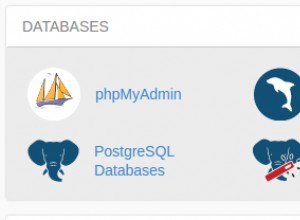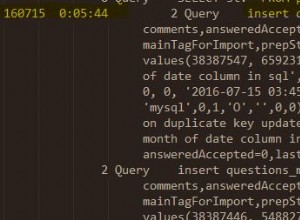Considere o seguinte esquema com a 3ª tabela sendo a Tabela Auxiliar ano/mês mencionada. As tabelas auxiliares são muito comuns e podem ser reutilizadas em todo o seu código naturalmente. Vou deixar para você carregá-lo com dados de data substanciais. Observe, no entanto, a maneira como a data de término de cada mês foi montada para aqueles de nós que desejam fazer menos trabalho, permitindo que o mecanismo de banco de dados descubra anos bissextos para nós.
Você poderia ter apenas uma coluna nessa tabela auxiliar. Mas isso exigiria o uso de chamadas de função para datas de término em algumas de suas funções e isso significa mais lentidão. Nós gostamos rápido.
Esquema
create table workerRecords
( id int auto_increment primary key,
the_date date not null,
staff_no int not null
);
-- truncate workerRecords;
insert workerRecords(the_date,staff_no) values
('2016-06-10',1),
('2016-06-09',1),
('2016-05-09',1),
('2016-04-09',1),
('2016-03-02',2),
('2016-07-02',2);
create table workers
( staff_no int primary key,
full_name varchar(100) not null
);
-- truncate workers;
insert workers(staff_no,full_name) values
(1,'David Higgins'),(2,"Sally O'Riordan");
Tabela auxiliar abaixo
create table ymHelper
( -- Year Month helper table. Used for left joins to pick up all dates.
-- PK is programmer's choice.
dtBegin date primary key, -- by definition not null
dtEnd date null
);
-- truncate ymHelper;
insert ymHelper (dtBegin,dtEnd) values
('2015-01-01',null),('2015-02-01',null),('2015-03-01',null),('2015-04-01',null),('2015-05-01',null),('2015-06-01',null),('2015-07-01',null),('2015-08-01',null),('2015-09-01',null),('2015-10-01',null),('2015-11-01',null),('2015-12-01',null),
('2016-01-01',null),('2016-02-01',null),('2016-03-01',null),('2016-04-01',null),('2016-05-01',null),('2016-06-01',null),('2016-07-01',null),('2016-08-01',null),('2016-09-01',null),('2016-10-01',null),('2016-11-01',null),('2016-12-01',null),
('2017-01-01',null),('2017-02-01',null),('2017-03-01',null),('2017-04-01',null),('2017-05-01',null),('2017-06-01',null),('2017-07-01',null),('2017-08-01',null),('2017-09-01',null),('2017-10-01',null),('2017-11-01',null),('2017-12-01',null),
('2018-01-01',null),('2018-02-01',null),('2018-03-01',null),('2018-04-01',null),('2018-05-01',null),('2018-06-01',null),('2018-07-01',null),('2018-08-01',null),('2018-09-01',null),('2018-10-01',null),('2018-11-01',null),('2018-12-01',null),
('2019-01-01',null),('2019-02-01',null),('2019-03-01',null),('2019-04-01',null),('2019-05-01',null),('2019-06-01',null),('2019-07-01',null),('2019-08-01',null),('2019-09-01',null),('2019-10-01',null),('2019-11-01',null),('2019-12-01',null);
-- will leave as an exercise for you to add more years. Good idea to start, 10 in either direction, at least.
update ymHelper set dtEnd=LAST_DAY(dtBegin); -- data patch. Confirmed leap years.
alter table ymHelper modify dtEnd date not null; -- there, ugly patch above worked fine. Can forget it ever happened (until you add rows)
-- show create table ymHelper; -- this confirms that dtEnd is not null
Então essa é uma tabela auxiliar. Configure uma vez e esqueça por alguns anos
Observação :Não se esqueça de executar o stmt de atualização acima
Teste rápido para sua consulta
SELECT DATE_FORMAT(ymH.dtBegin,'%b %Y') as month,
ifnull(COUNT(wr.the_date),0) as total_records,@soloName as full_name
FROM ymHelper ymH
left join workerRecords wr
on wr.the_date between ymH.dtBegin and ymH.dtEnd
and wr.staff_no = 1 and wr.the_date between '2016-04-01' and '2016-07-31'
LEFT JOIN workers w on w.staff_no = wr.staff_no
cross join (select @soloName:=full_name from workers where staff_no=1) xDerived
WHERE ymH.dtBegin between '2016-04-01' and '2016-07-31'
GROUP BY ymH.dtBegin
order by ymH.dtBegin;
+----------+---------------+---------------+
| month | total_records | full_name |
+----------+---------------+---------------+
| Apr 2016 | 1 | David Higgins |
| May 2016 | 1 | David Higgins |
| Jun 2016 | 2 | David Higgins |
| Jul 2016 | 0 | David Higgins |
+----------+---------------+---------------+
Funciona bem. A primeira tabela mysql é a tabela Helper. Uma junção à esquerda para trazer os registros do trabalhador (permitindo nulo). Vamos fazer uma pausa aqui. Afinal, esse era o objetivo da sua pergunta:dados ausentes . Finalmente a tabela do trabalhador em uma junção cruzada.
A
cross join é inicializar uma variável (@soloName ) que é o nome do trabalhador. Considerando que o status nulo de datas ausentes conforme você solicitou é obtido através do ifnull() função retornando 0, não temos esse luxo para o nome de um trabalhador. Isso força a cross join . Uma junção cruzada é um produto cartesiano. Mas como é uma única linha, não sofremos com os problemas normais que temos com os cartesianos causando muitas linhas no conjunto de resultados. De qualquer forma, funciona.
Mas aqui está um problema:é muito difícil manter e inserir valores em 6 lugares, como pode ser visto. Portanto, considere abaixo um proc armazenado para ele.
Procedimento armazenado
drop procedure if exists getOneWorkersRecCount;
DELIMITER $$
create procedure getOneWorkersRecCount
(pStaffNo int, pBeginDt date, pEndDt date)
BEGIN
SELECT DATE_FORMAT(ymH.dtBegin,'%b %Y') as month,ifnull(COUNT(wr.the_date),0) as total_records,@soloName as full_name
FROM ymHelper ymH
left join workerRecords wr
on wr.the_date between ymH.dtBegin and ymH.dtEnd
and wr.staff_no = pStaffNo and wr.the_date between pBeginDt and pEndDt
LEFT JOIN workers w on w.staff_no = wr.staff_no
cross join (select @soloName:=full_name from workers where staff_no=pStaffNo) xDerived
WHERE ymH.dtBegin between pBeginDt and pEndDt
GROUP BY ymH.dtBegin
order by ymH.dtBegin;
END$$
DELIMITER ;
Teste o proc armazenado várias vezes
call getOneWorkersRecCount(1,'2016-04-01','2016-06-09');
call getOneWorkersRecCount(1,'2016-04-01','2016-06-10');
call getOneWorkersRecCount(1,'2016-04-01','2016-07-01');
call getOneWorkersRecCount(2,'2016-02-01','2016-11-01');
Ah, muito mais fácil de trabalhar (em PHP, c#, Java, você escolhe). A escolha é sua, proc armazenado ou não.
Proc Armazenado de Bônus
drop procedure if exists getAllWorkersRecCount;
DELIMITER $$
create procedure getAllWorkersRecCount
(pBeginDt date, pEndDt date)
BEGIN
SELECT DATE_FORMAT(ymH.dtBegin,'%b %Y') as month,ifnull(COUNT(wr.the_date),0) as total_records,w.staff_no,w.full_name
FROM ymHelper ymH
cross join workers w
left join workerRecords wr
on wr.the_date between ymH.dtBegin and ymH.dtEnd
and wr.staff_no = w.staff_no and wr.the_date between pBeginDt and pEndDt
-- LEFT JOIN workers w on w.staff_no = wr.staff_no
-- cross join (select @soloName:=full_name from workers ) xDerived
WHERE ymH.dtBegin between pBeginDt and pEndDt
GROUP BY ymH.dtBegin,w.staff_no,w.full_name
order by ymH.dtBegin,w.staff_no;
END$$
DELIMITER ;
Teste rápido
call getAllWorkersRecCount('2016-03-01','2016-08-01');
+----------+---------------+----------+-----------------+
| month | total_records | staff_no | full_name |
+----------+---------------+----------+-----------------+
| Mar 2016 | 0 | 1 | David Higgins |
| Mar 2016 | 1 | 2 | Sally O'Riordan |
| Apr 2016 | 1 | 1 | David Higgins |
| Apr 2016 | 0 | 2 | Sally O'Riordan |
| May 2016 | 1 | 1 | David Higgins |
| May 2016 | 0 | 2 | Sally O'Riordan |
| Jun 2016 | 2 | 1 | David Higgins |
| Jun 2016 | 0 | 2 | Sally O'Riordan |
| Jul 2016 | 0 | 1 | David Higgins |
| Jul 2016 | 1 | 2 | Sally O'Riordan |
| Aug 2016 | 0 | 1 | David Higgins |
| Aug 2016 | 0 | 2 | Sally O'Riordan |
+----------+---------------+----------+-----------------+
A lição
As tabelas auxiliares são usadas há décadas. Não tenha medo ou vergonha de usá-los. Na verdade, tentar fazer algum trabalho especializado sem eles é quase impossível às vezes.




